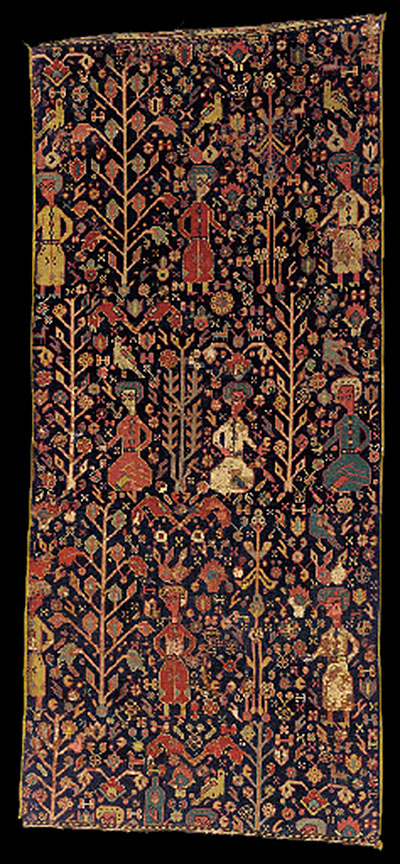|
A NORTH WEST PERSIAN RUG
18TH CENTURY
Price Realized £17,625
($25,292)
Sale Information
Christie's SALE 6435 —
ORIENTAL RUGS AND CARPETS
3 May 2001
London, King Street
LOT NOTES
Lot Description
A NORTH WEST PERSIAN RUG
18th Century
The blue field scattered with minor motifs, animals and birds around
angular flowering and leafy vine together with seated and standing human
figures, a trace of an ivory border at each end, otherwise lacking
borders, small repairs and some repiling
6ft.11in. x 3ft.4in. (211cm. x
102cm.)
Lot Notes
This very unusual fragment relates to a small
group of late and post-Safavid carpets which were woven in North West
Persia. They derive their designs from those of carpets of the classic
early Safavid period; they are woven however with a variety of structures
and therefore do not fit easily into a single homogenous group. They were
published and discussed at some length by Ian Bennett ("Animal and Tree
Carpets, an Amorphous Group", Hali 73, February/March 1994, pp.91-99).
Even within this amorphous group, the present rug stands out. Very few
of the other rugs have human figures, and when they do, their angular
figures are hunting stylised animals in the forest. Here there is a
completely different feeling: the figures are stationary, either standing
or seated, even if some of them look frankly angry at where they have been
placed! The structure also places it apart from most of the others
identified by Bennett. It has an ivory 3ZS warp and two shoots of maroon
lightly plied wool as weft, occasionally using four shoots. This accords
with the "proto-Kurdish" group identified by Alberto Levi, also from North
West Persia ("Renewal and Innovation", Hali 70, pp.84-93, esp.p.87). It
also relates it to two of the examples in group B identified by Bennett;
the Oakland carpet and the Bechirian rug, now in the Thysen Bornemisza
Collection (Spuhler, Friedrich: The Thyssen-Bornemisza Collection, Carpets
and Textiles, London, 1998, no.35, pp.144-5).
 |

